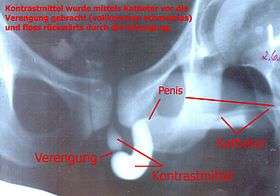Retrograde urethrogram
A retrograde urethrogram is a routine radiologic procedure (most typically in males) used to image the integrity of the urethra. Hence a retrograde urethrogram is essential for diagnosis of urethral injury, or urethral stricture.[1][2]
| Retrograde urethrogram | |
|---|---|
 Urethrogram showing an urethra stricture in a man. | |
| ICD-9 | 87.76 |
| OPS-301 code | 3-13g |
Process
The procedure involves the insertion of a Foley catheter into the distal urethra and minimally inflating it. This is followed by instillation of 30mL of water-soluble contrast and a plain radiograph is obtained; leakage of the contrast suggests urethral injury (usually secondary to pelvic trauma) and is an indication for surgical intervention.
It is used when there is suspicion of urethral trauma, such as a history of trauma to the area followed by pain, inability to void urine, or the presence of blood at the urethral meatus, a scrotal hematoma, or free-floating prostate on rectal examination.
If a urethral injury is suspected, a retrograde urethrogram should be performed before attempting to place a Foley catheter into the bladder. If there is a urethral disruption, a suprapubic catheter should be placed.
See also
- Retrograde ureteral, an intervention used to remove kidney stones
References
- El-Ghar MA, Osman Y, Elbaz E, Refiae H, El-Diasty T (July 2009). "MR urethrogram versus combined retrograde urethrogram and sonourethrography in diagnosis of urethral stricture". Eur J Radiol. 74 (3): e193–e198. doi:10.1016/j.ejrad.2009.06.008. PMID 19608363.
- Maciejewski, Conrad; Rourke, Keith (2015-12-02). "Imaging of urethral stricture disease". Translational Andrology and Urology. 4 (1): 2–9. ISSN 2223-4691.
External links
- New England Journal of Medicine procedure videos: Male Urethral catheterization
- Ohio State University Patient Education Materials: Retrograde Urethrogram